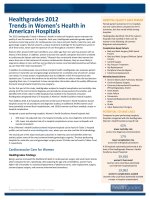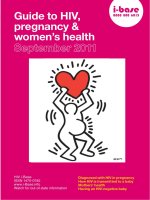First Trimester Pregnancy and Women’s Health pptx
Bạn đang xem bản rút gọn của tài liệu. Xem và tải ngay bản đầy đủ của tài liệu tại đây (326.95 KB, 7 trang )
Organized by Anita Pitock,
Esquire a nurse attorney at
Anapol Schwartz.
Contact Greg Spizer, Esquire
Email:
Toll Free: (866) 735-2792
Read more information online at:
www.anapolschwartz.com
© 2011 All Rights Reserved.
MEDICAL DISCLAIMER: This PDF
is not designed to and does not provide
medical advice, professional diagnosis,
opinion, treatment or services or other-
wise engage in the practice of medicine,
to you or to any other individual. Please
use this information to help in your
conversation with your physician. This is
general information and always seek the
advice of your physician or other quali-
fied health provider with any questions
you may have regarding a medical condi-
tion. Never disregard or delay seeking
professional medical advice or treatment
because of content found in the PDF,
website, or newsletter.
ATTORNEY DISCLAIMER: This PDF is dedicated to providing general public information regarding legal
rights. None of the information on this PDF is intended to be formal legal advice, nor the formation of a lawyer
or attorney client relationship. Please contact a Lawyer for information regarding your particular case. This PDF is
not intended to solicit clients outside the states of Pennsylvania, New Jersey, Ohio, West Virginia and Arizona.
First Trimester Pregnancy
and Women’s Health
Do’s and Don’ts, Nutrition, Harmful Prescription Drugs, Birth Defects
CONTENTS
You’re pregnant. Do’s and Don’ts 2
What happens during the first trimester week by week? 2
What are first trimester symptoms? 3
How to effectively handle some first trimester symptoms? 3
Prenatal nutrition 4
Teratogenicity 5
Prescription drugs 6
Birth defects 6
WARNING: Topamax Birth Defect Risk 6
Resources 7
2
FIRST TRIMESTER PREGNANCY AND WOMEN’S HEALTH
Copyright © 2004–2011 All rights reserved. Anapol Schwartz.
Read more information online at www.anapolschwartz.com.
Discuss all your medications, vitamins, and supplements with •
your doctor.
Stop tanning treatments and don’t dye/perm/straighten your •
hair with chemical solutions.
Avoid x-rays and MRIs.•
Avoid eating sushi, partially cooked meat or fish, deli meats, •
or soft cheeses (because of the possibility for bacteria).
Tell your doctor, nurse, or dentist that you are pregnant. •
Do get prenatal care, practice good nutrition, and get •
adequate rest as soon as possible.
WHAT HAPPENS DURING THE FIRST
TRIMESTER WEEK BY WEEK?
Weeks 1 & 2 are calculated as the first two weeks of •
pregnancy even though the pregnancy does not actually exist.
Weeks 1 & 2 are before conception and include the woman’s
last period.
Week 3—fertilization occurs •
Week 4—implantation happens •
Week 5—embryonic period; the baby’s brain, spinal cord, •
heart and other organs begin to form; a baby is between 1/8
and 1/16 inches long
Week 6 & 7—baby develops basic facial features; arms and •
legs start to grow; at week 7 baby weighs less than half an
ounce
Week 8—the baby starts moving but you won’t feel it•
Week 9, 10, 11 & 12—the baby’s toes, neck, and genitals •
develop
According to the American Pregnancy Association, by the end 12
weeks, the fetus will be about 3 inches.
You’re going to have a baby. You’re going to be a mother. You’re going to start a family or extend your family
and couldn’t be happier and more excited or more stressed and conflicted. Every woman will experience
pregnancy differently.
YOU’RE PREGNANT. DO’S AND DON’TS
Stop smoking cigarettes, if you do.•
Stop using drugs, if you do.•
Stop drinking beer, wine, and cocktails.•
[Ultrasound at 9 weeks]
FIRST TRIMESTER PREGNANCY AND WOMEN’S HEALTH
Copyright © 2004–2011 All rights reserved. Anapol Schwartz.
Read more information online at www.anapolschwartz.com.
3
WHAT ARE FIRST TRIMESTER
SYMPTOMS?
Nausea—morning (morning sickness), noon, •
and night (hang in there!)
Nipples and areolas darken due to a •
temporary increase in hormones
Cramping is normal; spotting and bleeding is •
not; contact your doctor if this happens
Weight gain•
Frequent urination •
Breast tenderness•
Headaches & dizziness •
Tired all the time or increased energy•
Overly emotional or an incredible sense of •
well-being
HOW TO EFFECTIVELY HANDLE SOME FIRST
TRIMESTER SYMPTOMS?
Nausea—An empty stomach or too full stomach creates •
problems; eat smaller meals more frequently and drink less
liquids with meals; avoid unpleasant smells or odors; get
more rest.
Weight gain—You will probably gain about 3 or 4 pounds; •
that’s a good thing.
Frequent urination—Do not restrict liquids during the •
day because you need to stay hydrated but avoid drinking
anything prior to bedtime. Frequent urination should diminish
around the fourth month.
Breast tenderness—Buy a good support bra that is •
comfortable and possible to sleep in at night.
Headaches—Learn breathing exercises and meditation which •
can help relieve stress and provide relaxation; avoid taking
pain killers if possible or ask your doctor about safe options.
Never take any over-the-counter herbs or drugs without
consulting a health professional.
Dizziness—Keep your blood sugar level (healthy snacking •
helps in that respect); avoid getting up from the chair or bed
too quickly.
Tired all the time or increased energy—Indulge in plenty of •
rest.
Overly emotional or an incredible sense of well-being—It’s a •
hormonal thing.
FIRST TRIMESTER PREGNANCY AND WOMEN’S HEALTH
Copyright © 2004–2011 All rights reserved. Anapol Schwartz.
Read more information online at www.anapolschwartz.com.
4
PRENATAL NUTRITION
A balanced diet is very important for healthy pregnancy. Eat •
carbohydrates, fat, and proteins, and a variety of fruits and
vegetables.
Folic acid, folate or vitamin B9 (all the same) has been proven •
to limit a serious birth defect, spina bifida.
Calcium, vitamins, other micronutrients like iron•
Consume adequate amounts of DHA omega-3, a major •
structural fatty acid that supports a mother’s well-being and
the health of her infant. In a study of nearly 9,000 pregnant
women, researchers found women who ate fish once a week
during their first trimester, had 3.6 times less risk of low
birth weight and premature birth than those who ate no fish.
Low consumption of fish was a strong risk factor for preterm
delivery and low birth weight. Fish should be low in mercury.
Note: Other studies do not have the same conclusion.
Avoid tuna, swordfish, shark,
king mackerel and tilefish.
Now is not the time to pig out on junk food. •
Always ask your doctor or nurse practitioner for nutrition •
advice.
FIRST TRIMESTER PREGNANCY AND WOMEN’S HEALTH
Copyright © 2004–2011 All rights reserved. Anapol Schwartz.
Read more information online at www.anapolschwartz.com.
5
A wide range of different drugs, chemicals, and environmental fac-
tors are known to be teratogenic in humans and in animals. Here is a
smattering:
DRUGS AND MEDICATIONS:• tobacco, drinking alcohol,
androgenic hormones, lithium, tetracyclines, Dilantin,
coumarin, methoxyethyl ethers, busulfan, valproic acid,
enalaprin. A single dose of Roaccutane for acne may result in
serious birth defects.
ENVIRONMENTAL CHEMICALS:• PCB, dioxin,
hexachlorobenzene hexachlorophene, organic mercury,
ethidium bromide
IONIZING RADIATION: • atomic weapons fallout, background
radiation, diagnostic x-rays, radiation therapy
INFECTIONS: • herpes virus, parvovirus B19, German measles,
syphilis, toxoplasmosis, CMV, HSV
METABOLIC IMBALANCE: • alcoholism, endemic cretinism,
diabetes, folic acid deficiency, iodine deficiency, hyperthermia
Additional agents include Agent Orange, nicotine, other NSAIDs, and
aspirin. This list is under debate mainly because pregnant women can-
not be subject to the above agents so there is very little documented
data as to cause and effect.
Teratogenic effects also help to determine the FDA (Food & Drug Ad-
ministration) pregnancy category for drug safety. A pregnancy cat-
egory of C, D, or X may be assigned if teratogenic effects are docu-
mented or cannot be excluded.
The period from the 8th day to the end of 8th week (second month)
is the period during which the organs are formed in the fetus. This
is the most crucial time with regard to structural malformations and
concerns from dangerous drugs.
TERATOGENICITY
What is teratogenicity (ter·a·to·ge·nic·i·ty)? Sub-
stances with teratogenic effects can damage the
DNA of a developing fetus. It is estimated that
10% of all birth defects are caused by prenatal
exposure to a teratogenic agent including but not
limited to—medication or drug exposures, ma-
ternal infections and diseases, and environmental
and occupational exposures. Teratogen-caused
birth defects are potentially preventable. Studies
have shown that nearly 50% of pregnant women
have been exposed to at least one medication
during gestation.
FIRST TRIMESTER PREGNANCY AND WOMEN’S HEALTH
Copyright © 2004–2011 All rights reserved. Anapol Schwartz.
Read more information online at www.anapolschwartz.com.
6
BIRTH DEFECTS
Birth defects are known to occur in 3–5% of all newborns. They are
the leading cause of infant mortality in the United States, account-
ing for more than 20% of all infant deaths. Seven to ten percent of
all children will require extensive medical care to diagnose or treat a
birth defect.
A congenital disorder, or congenital disease, is a condition existing at
birth and often before birth, or that develops during the first month of
life regardless of the cause.
Exposure to teratogens can result in a wide range of birth defects such
as cleft palate, cleft lip, ventricular septal defect, dysmelia (congenital
limb disorder), anencephaly disorder (a rare birth defect in which the
baby has a malformed skull and little or no brain).
WARNING: TOPAMAX BIRTH DEFECT RISK
The North American Antiepileptic Drug Pregnancy Registry (NAAED)
has shared data with the FDA showing an increased risk of cleft pal-
ates and cleft lips in infants exposed to Topamax or its generic topi-
ramate during the first trimester of pregnancy. Topamax is prescribed
for anti seizures and to prevent migraine headaches.
The relative risk for developing cleft palate
in infants of mothers who take Topamax
or its generic equivalent, compared to
infants of mothers not taking anti-seizure
medication, is more than double the risk.
If you want to discuss your child’s legal rights for a cleft palate injury
that you suspect was caused by Topamax (topiramate), please contact
the lawyers at Anapol Schwartz at 866.735.2792 or visit our web site
at www.anapolschwartz.com.
PRESCRIPTION DRUGS
The FDA has developed a rating system to pro-
vide therapeutic guidance based on potential
benefits and fetal risks. Drugs have been clas-
sified into categories A, B, C, D and X. Multi-
vitamins that have demonstrated no fetal risks
after controlled studies in humans are classified
as Category A.
Category B includes (not inclusive) penicillin,
cephalosporins, azithromycin, erythromycin,
acetaminophen (Tylenol), and caffeine
Category C includes (not inclusive) fluconizole,
heparin, aspirin, Vioxx
Category D includes (not inclusive) valproic
acid, valium, lithium, Topamax*
ACE inhibitors, ARBs, coumarins, and central
nervous system drugs
Category X includes (not inclusive) thalidomide
*Topamax moved from Category C after the
birth defect risk of cleft palates and cleft lips
almost doubled in newborns.
FIRST TRIMESTER PREGNANCY AND WOMEN’S HEALTH
Copyright © 2004–2011 All rights reserved. Anapol Schwartz.
Read more information online at www.anapolschwartz.com.
7
RESOURCES
American Pregnancy Association
FDA Pregnancy Drug Categories & Teratogens
Net Wellness
Pregnancy Support Groups
WebMD
Topamax Birth Defects Lawsuit
The Cleft Lip and Palate Foundation of Smiles
Network for people to join to get support, meet families, build relationships, ask questions and get answers!









